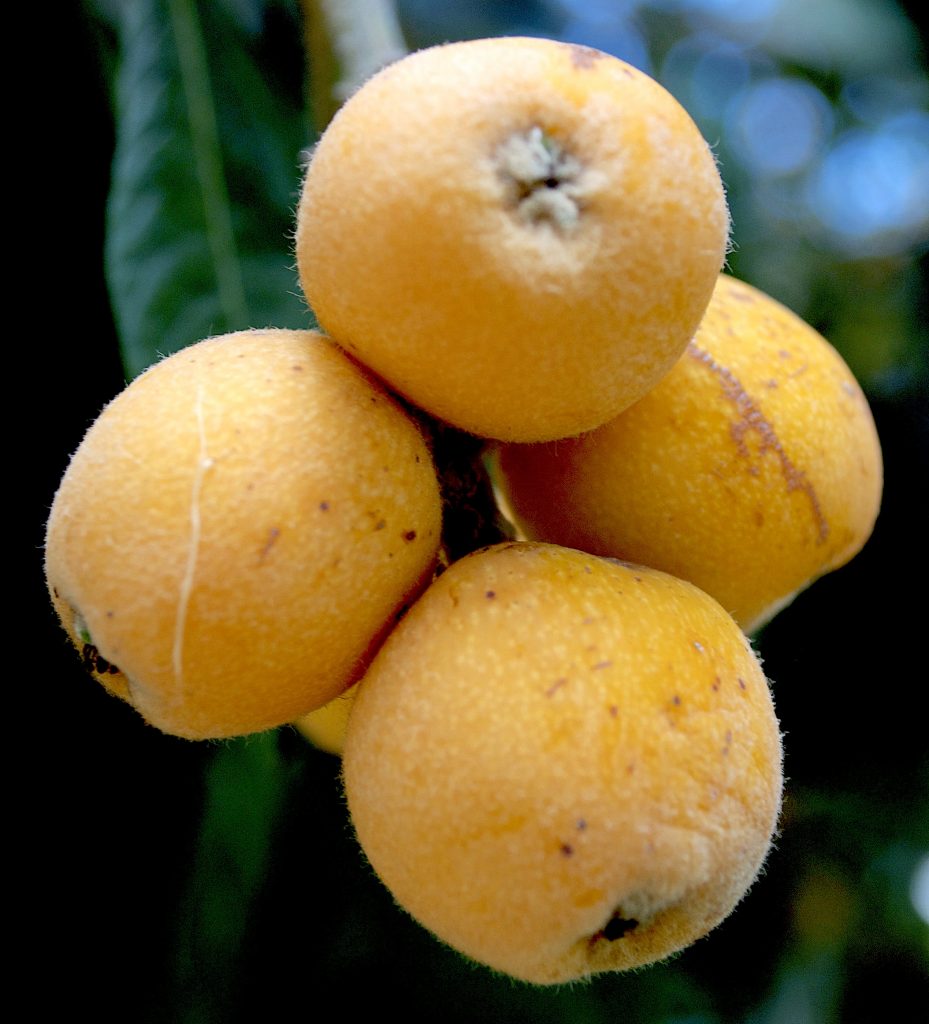
Heads up, literally: Loquats are ripening. First you will see just an occasional ripe fruit, then noticeably more. Then the fruit flood gate opens. Loquats, planted and naturalized, are a much-anticipated tasty fruit that do not travel well. One rarely sees them in local markets. They bruise easily and begin to lose their bright yellow color within hours of picking. The refrigerator does not treat them well, either. While loquats can be canned I think the best way to preserve this bounty is by dehydration. I cut around the fruit’s equator, remove the seeds for other use, then dry the two halves. Some people dip the halves in a sulfur solution first but I have not found that to improve looks, flavor or preservation. The reason why I recommend dehydrating them is you end up with a delicious product. Some fruits do not dehydrate well, loosing flavor and or texture. Mulberries are a good example. They are best fresh. And while dried loquats don’t taste like fresh loquats — as prunes don’t taste like plums — they are good dehydrated and store well. Do know the green fruit is toxic particularly to children. I have a video on Loquats here and a large article here.
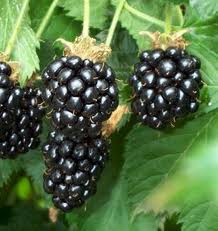
Several plants are sensing the end of winter is near. Red Mulberries are leafing out and at the same time starting young, green fruit. The young leaves are edible cooked. The unripe green fruit is mildly mind-altering but will upset the stomach. Try not to eat them. Also seen while foraging are blossoming Blackberries. There are two kinds of Blackberries locally, those that grow canes and those that crawl along the ground. Both produce edible fruit. Also noticed along the way are Maypops. They are not unusual, in fact very common. But until they get a foot long or so they grow upright and look like a vertical plant. But somewhere between 12 and 15 inches tall the plant keels over and becomes the familiar vine that can grow a hundred feet or so. And if one looks closely here and there one can also find early ripe Creeping Cucumbers .
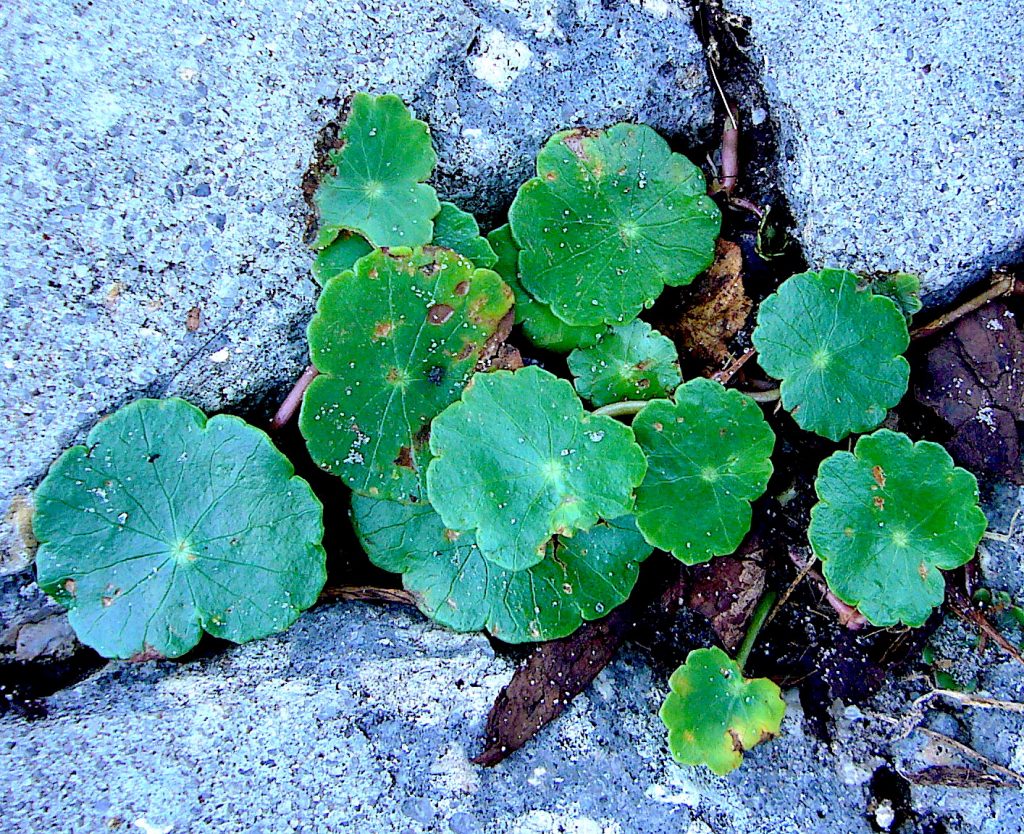
A question arose this week regarding a very common wet-ground plant, Dollarweed. From an edible point of view we tend to refer to all the Dollarweeds as one as they are all edible. But there are six or seven different species depending on how one counts. What most folks don’t know is that the Dollarweeds are in the Ginseng Family and taste similar to carrot tops. The species’ differences are usually minor but that is the thing different species are made of. Some have hairy stems, other do not. Some have spike blossoms others a raceme. Stem thickness also counts and does whether the leaves are cleffed or not or in the language of botany: “A deep basal sinus extending to the petiole.” Dollarweeds are also closely related to Gotu Kola which is also in the Ginseng family. The Dollarweed species are Hydrocotyle umbellata, H. bowlesioides, H. ranunculoides, H. sibthorpioides, H. bonariensis, H. verticillata and H. verticillata variation tridadiata.
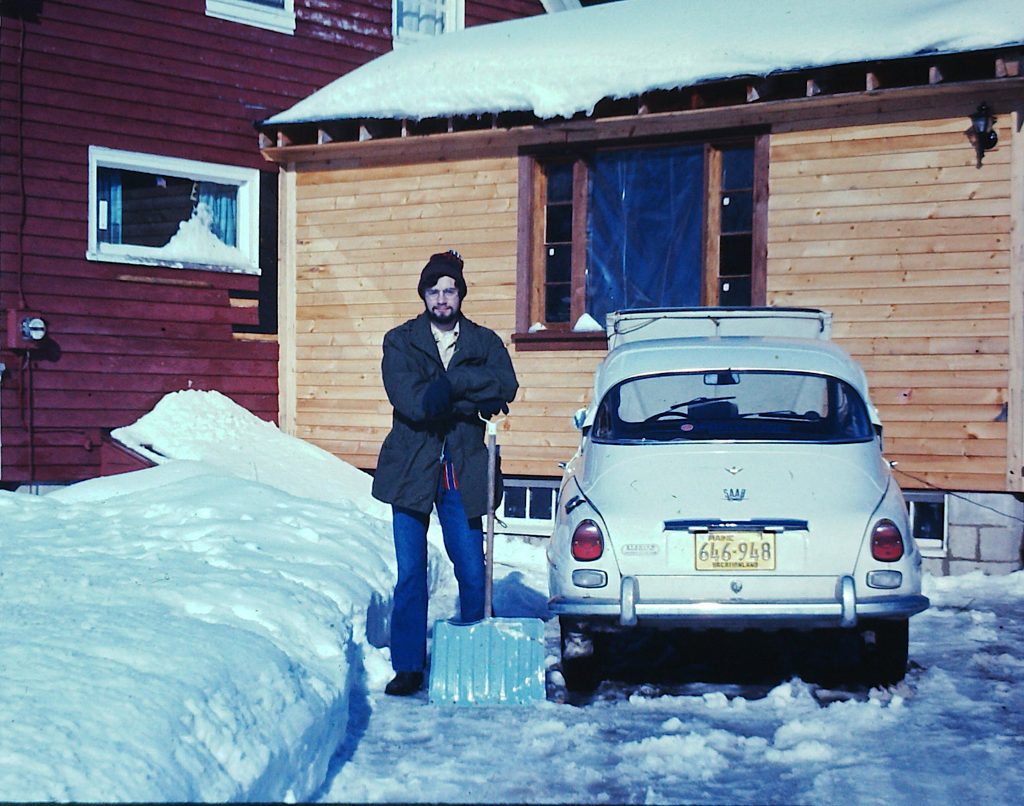
It’s that strange time of year in Florida. Will it be 38 degrees tomorrow or 83? And if we’re going from one temperature to the other — the direction is not too relevant — it will probably rain. Now days we can look at the forecast and stay inside. We have food in the pantry. In the past, though, if you didn’t forage you didn’t eat. Only weather that was worse than your hunger kept you from foraging. We have the luxuries of extra food and not having to go out in bad weather… Once, when I was in school, we had a storm that snowed us in for three days. That was the year you could jump off the roof into the snow and not bottom out. A neighbor, Henry Wright, had a stroke. An emergency plow cleared the road to his house for the ambulance. Another time when I was younger an ice storm covered the snow so thick that you could skate for miles across the fields on the snow and not break through. Once it was so cold the schools had to shut down for the week. They couldn’t keep them warm. That is weather you don’t forage in. But here in Florida my foraging classes are only called off because of accident, injury or hurricanes. My upcoming schedule is below.

Foraging Classes: I did not have any official classes last weekend as I was teaching at the 8th Annual Florida Herbal Conference east of Lake Wales. The weather was as good as it was bad two years ago. Mother Nature should also be cooperating this coming weekend. Note Saturday’s class is in my metaphorical back yard, Orlando. Sunday I’ll ride my motorcycle down the turnpike for a class in Ft. Pierce.
Saturday, March 2nd, Blanchard Park, 10501 Jay Blanchard Trail, Orlando, FL 32817. Meet near the tennis court near the YMCA building. 9 a.m. to noon.
Sunday, March 3rd, George LeStrange Preserve, 4911 Ralls Road, Fort Pierce, FL, 34981. 9 a.m. to noon. The preserve has no official bathroom or drinking water so take advantage of the various eateries and gas stations before arrival.
Saturday, March 9th, Florida State College, south campus, 11901 Beach Blvd., Jacksonville, 32246. 9 a.m. to noon. We will meet at building “D” next to the administration parking lot.
Sunday, March 10th, Haulover Canal, Merritt Island National Refuge, north of the Kennedy Space Center, 9 a.m. to noon or later. Because of its shape this class requires the most walking and climbing, about four miles. We meet at the end of the northwest jetty. Take the time change into account that day so you are on time.
Saturday March 16th, Wickham Park: 2500 Parkway Drive, Melbourne, FL 32935-2335. 9 a.m. to noon. Meet at the “dog park” inside the park.
Sunday, March 17th, Red Bug Slough Preserve, 5200 Beneva Road, Sarasota, FL, 34233. 9 a.m. to noon.
Saturday, March 23rd, Blanchard Park, 10501 Jay Blanchard Trail, Orlando, FL 32817. Meet near the tennis court near the YMCA building. 9 a.m. to noon.
Sunday, March 24th, Bayshore Live Oak Park, Bayshore Drive. Port Charlotte. 9 a.m. to noon. Meet at the parking lot at the intersection of Bayshore Road and Ganyard Street.
For more information on classes or to sign up go here.

I had to share this next snippet with you. On the Green Deane Forum a book was mentioned, Weeds of the South. So I ordered it, not expensive. All in all it is a good book written for farmers and livestock breeders et cetera. One distraction is the near-paranoia the writers and editors have over wild edibles, listing most if not all of them as toxic. A bad attitude towards edible weeds is basically institutionalized in the United States. If one can ignore that ugly little entry on each page it’s a good book with excellent descriptions and pictures. Sometimes however the description just misses the mark. Under “special identifying features” for the deadly Poison Hemlock it says: Herbage has a mouse-like odor… Mouse-like odor? Who smells mice? Have you ever smelled a mouse? Do you know anyone who has? I haven’t. That’s the writer and the editor not thinking about the reader. The closest I’ve ever come to smelling a mouse is my grandmother had a pet rat who got a bath with a toothbrush once a week in a warm oven.
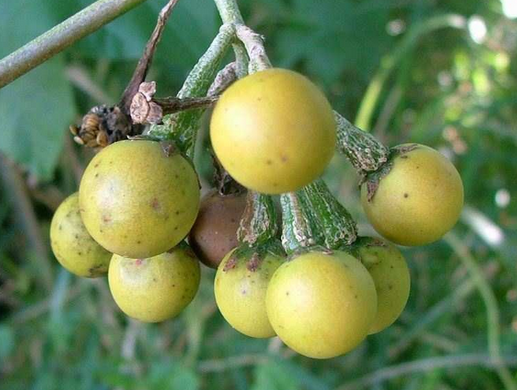
Showing up in a few back yards in south Florida is the Turkey Berry, Solanum torvum. It’s an iffy plant. The Turkey Berry has been used for roots stock for eggplants. Its bitter immature fruit are eaten but they might cause liver tumors (Balachandran and Sivaramkrishnan, 1995, Induction of tumors by Indian dietary constituents.). Turkey Berry was first found in Florida in 1899 and is now identified in nine counties. It’s also a weed in 32 countries and is invasive in Australia and South Africa. Armed with spines, it has gray bark, and green pea-sized fruit that ripen to yellow. The half-grown green immature fruits are used in Thai cuisine and are an essential ingredient of Thai yellow curry. In India, the fruit is consumed directly, or as cooked food. Young shoots are eaten raw or cooked. In Jamaica the immature fruit are boiled and eaten. That said the Turkey Berry contains a number of potentially harmful chemicals. And while I could not find any reference about this its fruits might become more toxic as they ripen as the Tropical Soda Apple does. The Turkey Berry’s lobed leaves alternate and are broadly triangular. However there are no thorns on the top part of the leaves. Ripe berries are drab yellow drying to black. A far more edible member of the nightshade family escaped in south Florida and cultivated in northern climes is the Litchi tomato. You can read about it here.
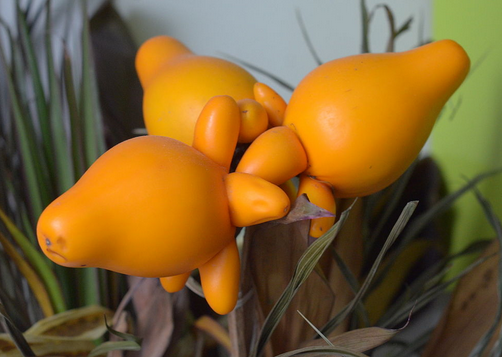
A perennial question on the Green Deane Forum’s UFO page (unidentified flowering objects) is about prickly plants growing what looks like tomatoes. Sometimes the fruit is red, sometimes yellow. The quick answer is “it’s some kind of ‘soda apple’ and not edible.” We could leave the discussion right there but usually people want to know more. At least seven prickly “non-tomatoes” show up regularly on the forum. A few are native, most are imported. To read more about them and help you identify “toxic tomatoes” go here.

Want to identify a plant? Looking for a foraging reference? Do you have a UFO, an Unidentified Flowering Object you want identified? On the Green Deane Forum we chat about foraging all year. And it’s not just about warm-weather plants or just North American flora. Many nations around the world share common weeds so there’s a lot to talk about. There’s also more than weeds. The reference section has information for foraging around the world. There are also articles on food preservation, and forgotten skills from making bows to fermenting food. One special section is “From the Frightening Mail Bag” where we learn from people who eat first then ask questions later. You can join the forum by clicking on “forum” in the menu.

All My Videos are available for free on You Tube. They do have ads on them so every time you watch a Green Deane video I get a quarter of one cent. Four views, one cent. Not exactly a large money-maker but it helps pays for this newsletter. If you want to see the videos without ads and some in slightly better quality you can order the DVD set. It is nine DVDs with 15 videos on each for a total of 135 videos. Many people want their own copy of the videos or they have a slow service and its easier to order then to watch them on-line. The DVDs make a good gift for that forager you know especially on long, cold winter months. Individual DVDs can also be ordered or you can pick and choose. You can order them by clicking on the button on the top right hand side of this page (if your window is open wide enough.) Or you can go here.

Donations to upgrade EatTheWeeds.com have gone well. Thank you to all who have contributed to either via the Go Fund Me link, the PayPal donation link or by writing to Green Deane POB 941793 Maitland FL, 32794. There are many needs left such as expanding the foraging teacher page and the page on monotypic edibles. I’m still having a hard time finding articles I wrote! There’s always something and such things get more complex and expensive every year. Indeed, the average email cost to send each newsletter is $20.
If you would like to donate to Eat The Weeds please click here. Or you can use my Go Fund Me link, or by writing to Green Deane POB 941793 Maitland FL, 32794
This is weekly issue 345.


New here, and just loving your newsletter, great job and very informative.
We harvest dollarweeds from our yard and really enjoy the slight carrot-y flavor. This past week, I baked them like I do kale chips. Little bit of olive oil, little bit of salt. 350* for 8-10 minutes. Kids loved them. They get a little bitter, but it’s fun to have little circle chips!
Thanks for all of the advice, information and tips you give! Have a great day! 🙂
This comment is related to “Go ungreen” . I kept sad and repentant on remembering the past good days – almost same as you’ve mentioned . Let me say ” We were living in hyperpassion while now we are living in hypopassion .” In other words we are sailing against the winds ; but with more patience l hope you’re strong enough to carry on the mission.